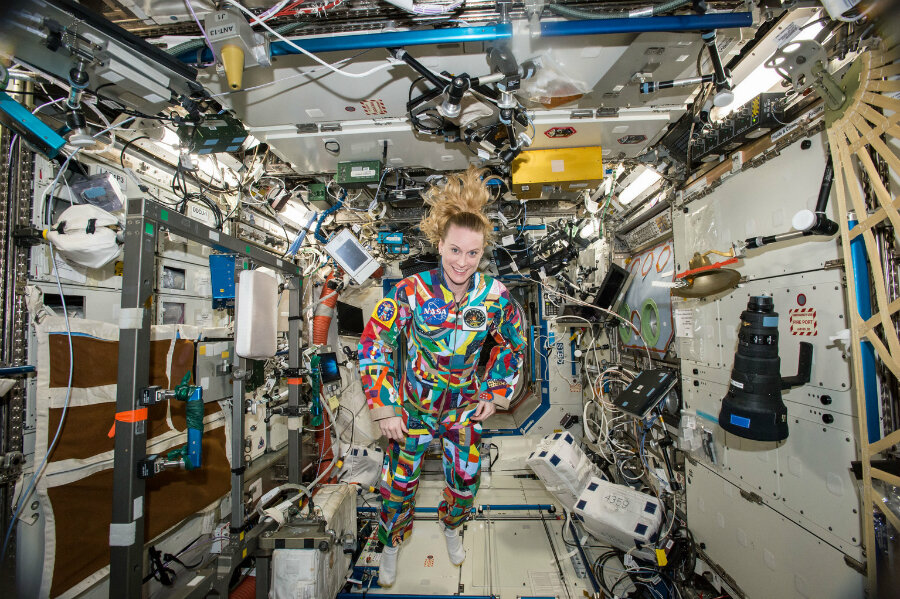This company plans to privatize the International Space Station
As the operating life of the International Space Station (ISS) draws closer to its end, private space companies are starting to step in to offer a post-ISS vision for the future of research and commercial activity in Earth’s orbit.
Axiom Space, a Houston-based startup that launched only in 2016, says it will soon begin building a module that it plans to ship and attach to the ISS in 2020 for testing. The company's ultimate goal is to replace the ISS – an 18-year-old, international science laboratory orbiting 240 miles above Earth – with a commercial version.
“It became quite obvious [to Axiom founders] that now that NASA is ceding low Earth orbit (LEO) to the commercial sector, that the opportunity was to build a private space station. . . . That’s really where they set out to build and to provide continuity for what the ISS has built over the years,” says Amir Blachman, vice president of strategic development at Axiom. The new company spun out of Stinger Ghaffarian Technologies (SGT) in Greenbelt, Md., a NASA contractor that helps the agency train astronauts and manage mission control among other things.
Axiom’s plans are music to NASA’s ears. “We want to see a robust commercial economy; we want to become a customer,” says NASA's Michael Read of Axiom's ambitions. Mr. Read, manager for commercial space utilization at NASA's Johnson Space Center in Houston, says that the agency has been in talks with the company for well over a year.
US space officials including Read have been diligently recruiting private companies like Axiom and others to LEO to take advantage of the billions of dollars that the agency has invested there over the years. Already astronauts aboard the space station conduct research in microgravity for private companies such as drugmakers Merck, Novartis, and Procter & Gamble, with NASA covering the costs to ship experiments to the ISS.
But NASA plans to stop funding the ISS in 2024, or at the latest 2028, to free the agency’s money and attention for loftier goals such as human travel to Mars.
“We’re going to get out of ISS as quickly as we can,” William Gerstenmaier, the agency’s chief of human spaceflight, said at a December 2015 meeting, according to ArsTechnica. “Whether it gets filled in by the private sector or not, NASA’s vision is we’re trying to move out.”
When the agency moves out, it's counting on private companies to step in to fill the void. Besides Axiom, which is helmed by former ISS manager Michael Suffredini and has two NASA astronauts in its senior ranks, Las-Vegas-based Bigelow Aerospace is also working to build a business in LEO.
Right now Bigelow has a 3,086-pound expandable pod made of layers of fabric and Kevlar-like material attached to the outside of ISS for a two-year test of the pod's resistance to space debris, temperature fluctuations, and solar and cosmic radiation. It could one day house astronauts during deep-space missions, or possibly space tourists on sightseeing trips, the company has said.
It could also offer a home for scientific research. The microgravity environment of space is well-suited to research spanning from health to materials sciences. One recent ISS project, for example, experimented with alloys, or metals that are widely used in a variety of Earthly products, from car parts to golf clubs to electronics and medical devices.
Axiom has estimated that there is a major business opportunity in providing a space in space for this type of research, says Mr. Blachman. “NASA does or subsidizes $300 million worth of research on the ISS,” he notes. “So when ISS is retired, that research is not going away; that market is only growing.”
Another space selling point, says Blachman, is the promise of manufacturing in microgravity. Fiber optics, a technology used in telecommunications, is a good candidate for production in space, where the gravity-free environment prevents shearing forces and convection, producing a more pure glass that can better transmit light.
“A strand of fiber manufactured in space can have a thousand times the throughput of a strand of fiber that’s manufactured on Earth,” Blachman says.
There are other ways that Axiom's space station is expected to make money, including training and housing astronauts from countries that have never sent people to space – he wouldn’t say which ones – and from serious space tourists who will train with Axiom for months in order to spend nearly a couple of weeks orbiting this planet.
But all of these revenue-generators are still far off. So far Axiom has been funded through a $3 million personal investment from SGT’s co-founder and head Kam Ghaffarian, according to Blachman. The startup is in the process now of raising money from investors to build a module that it hopes to launch and attach to the ISS in several years. The company plans also to begin training astronauts this year, and expects to send its first people to the ISS in 2019.
Then, between 2020 and 2024, Blachman says Axiom will ship two or three more modules to LEO; they will separate from the ISS when it retires to create a new, private station. Why not just rent out or hand over the ISS to a private company, instead of letting it fall in pieces down to Earth after it's decommissioned? Read says it is impossible to hand the station over to a company because it doesn’t belong to the United States alone; it is a collaboration among many countries, including Russia, Japan, and England. Though NASA likely will be able to give private companies equipment from the ISS.






